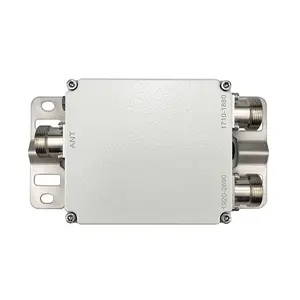(805 products available)


















































































































































































































A TOSLINK combiner is a device that combines multiple optical audio signals into one single output signal. There are different types of TOSLINK combiners.
Optical Switch
An optical switch is a device that allows the routing or selecting of optical signals from different sources. It works by utilizing the properties of light and typically employs mirror-like components to change the direction of light. The resulting outcome is that light is reflected to various paths or as fiber optic cables. An optical switch can be used to set different audio sources to a single output.
Optical Multiplexer
An optical multiplexer (MUX) combines multiple individual optical signals into a single aggregate optical signal over a shared physical medium or link. An optical MUX is the opposite of an optical demultiplexer. An optical demultiplexer (DEMUX) takes a single optical signal and splits it into multiple individual optical signals. Both devices are commonly used in fiber-optic communication networks. The optical MUX links multiple data streams to transmit them efficiently over one fiber link. At the receiving end, an optical DEMUX separates the combined signals back to their original individual streams. A TOSLINK combiner can make use of an optical multiplexer.
Passive Optical Combiner
Passive optical combiners combine multiple light signals without the use of electrical components. They are commonly used in optical networks to merge different light wavelengths into a single stream. This is often performed using fiber optic cables and couplers. Passive optical combiners are different from active combiners that depend on electronic power to function.
The specifications of a TOSLINK combiner can vary depending on the manufacturer and the model. However, here are some common specifications along with their maintenance requirements:
Input/output connectors
Depending on the type of connectors, users should gently insert or remove the cables to avoid applying excessive force to the connectors. Regularly check the connectors to ensure they are in good condition, and if they get loose or dirty, users should clean or repair them in time.
Optical fiber diameter
Users should handle the TOSLINK combiner with care to avoid damaging the optical fiber. Store the device in a suitable location when not in use to prevent the optical fiber from bending excessively or being pulled. If the optical fiber is dirty or damaged, users need to clean or replace it in time.
Frequency response
Users should avoid using devices that produce high volumes to protect the TOSLINK combiner from distortion and excessive pressure. In addition, users can use devices with a wide frequency response range to obtain better sound quality. Finally, check the sound quality output by the TOSLINK combiner from time to time. If the sound quality is poor, it may be that some components have worn out and need to be replaced.
Working temperature
Users should use the TOSLINK combiner within the specified working temperature range. When the environment temperature is too high or too low, it may affect the performance and lifespan of the device. In addition, users should keep the device dry and away from moisture and liquids to avoid damage and performance degradation.
With the increasing use of optical fiber technology in various industries, many sectors can potentially use a TOSLINK combiner.
Entertainment industry
In the film and television production and broadcasting industry, a TOSLINK combiner can be used in sound recording, post-production, and program broadcasting links. For example, when mixing soundtracks for movies or TV shows, multiple audio sources need to be combined and transmitted digitally. With excellent sound quality and anti-interference characteristics, TOSLINK combiners are useful for achieving this digital audio mixing.
Live events
In live broadcasts or on-stage performances, multiple audio sources such as performer voices and instrument sounds need to be mixed and transmitted to the audience through sound systems. A TOSLINK combiner can be employed to mix these different audio signals and ensure the audience receives high-quality digital audio.
Music production
In the process of music production and recording, multiple instrument recordings and vocal recordings need to be mixed and processed to produce the final music tracks. TOSLINK combiners can be used in this mixing and recording process to achieve high-fidelity digital audio mixing and transmission, ensuring excellent sound quality.
Broadcasting
In radio broadcasting studios, multiple audio sources such as voices, music, and sound effects need to be combined and transmitted. A TOSLINK combiner can be used to mix these different audio signals and broadcast them over the radio.
Home theater
In a home theater system, multiple audio devices such as TVs, game consoles, and streaming media players need to be connected to external sound systems or receivers. A TOSLINK combiner can be used to combine the audio output from these different devices and transmit it to the sound system, allowing users to enjoy high-quality audio coming from various sources.
Choosing a TOSLINK combiner requires careful consideration of specific needs and application requirements.
Q1: What is the purpose of a TOSLINK combiner?
A1: A TOSLINK combiner's main purpose is to merge two or more optical audio signals into a single output signal using light paths.
Q2: Can a TOSLINK combiner affect audio quality?
A2: When properly built, a TOSLINK combiner should not affect audio quality. However, it is possible to affect audio quality when the device is poorly manufactured, particularly when it has low-quality connectors and cables.
Q3: Do TOSLINK combiners require power?
A3: TOSLINK combiners are passive devices and therefore do not require power. Active combiners do require power, but there are purely passive TOSLINK combiners.
Q4: Can a TOSLINK combiner be used with non-TOSLINK signals?
A4: No, you cannot use a TOSLINK combiner with non-TOSLINK signals. The TOSLINK system transmits audio using light signals through optical fibers. Other systems may not require fiber optics.
Q5: Can a TOSLINK combiner be used with non-TOSLINK signals?
A5: No, you cannot use a TOSLINK combiner with non-TOSLINK signals. The TOSLINK system transmits audio using light signals through optical fibers. Other systems may not require fiber optics.